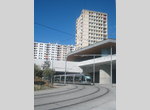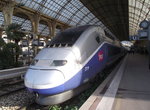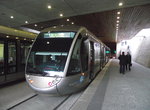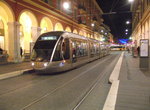Nice, France
![]()
Nice Tramway-Lignes d'Azur Citadis tram no. 018 at Libération (line 1). Photo by Bernard Chatreau, March 2008.
Overview
Transit fans traveling to Europe rarely regard the French Mediterranean port of Nice as a "must see" city. But the recent opening of the first element of a light rail system there, coupled with a couple of older rail operations, may well have raised the transit profile of the fifth largest city in France. Let’s take a fast look at three different operations in Nice.
Light Rail
The new light rail line in Nice is part of the region’s overall transit system, Lignes D’Azur, and consists in a “U” shaped line that links much of the city’s densely settled residential communities with the heart of the business and commercial district. Opened in November of 2007 and stretching some 5.4 miles, the line is served by a fleet of Alstom Citadis 302 model trams, three-truck and five-section articulated units that measure 115-feet from end to end. Twenty trams were initially acquired, but since on a recent visit I saw numbers as high as 026, and as low as 001, it would seem that additional cars have been added.
The length of station platforms (of which there are 28), would seem to preclude the operation of two-unit trains, but the Alstom design will permit the addition of two additional sections per tram. And since the line operates on a four-minute headway from early morning until well into the evening and carries rather heavy loads, this option may soon be explored.
The new line was very expensive to build; $590 million overall, or $109 million per mile has totally rejuvenated Nice, especially two large pedestrian friendly plazas downtown, Place Massena and Place Garibaldi. In fact, mindful of the fact that overhead catenary could well disrupt the visual aesthetics of these two open spaces, not to mention interfere with carnivals and other celebrations that are held in these areas, Nice worked with Alstom to develop a tram that could lower its pantograph as it passed through each of the plazas and operate, instead, from on-board batteries. Speed is restricted to 30 mph during battery operation, but given the high density nature of the two plazas, top speed is never required in these sections.
Nice's aversion to overhead wires has historic roots. The city's last conventional streetcars stopped running over 50 years ago, but this turn-of-the-century system eschewed overhead wires in downtown areas and used an underground conduit for current distribution similar to systems in New York, Washington and London. The current Nice catenary is quite unobtrusive, with support wires often attached to buildings rather than poles. While the system primarily involves street running, automotive traffic is excluded from the right-of-way, although people on motor scooters often fail to observe the restrictions. On one street the trams use, Avenue de la Republique, routine automotive traffic is completely excluded, save for deliveries to local stores and, of course, emergency vehicles.
The line’s northwestern terminal is called Pont Michel and consists in a simple enough three-track stub-end terminal. On the other end, Las Planas, the trams enter a short subway, of sorts, and then proceed beyond the station, emerge from the subway, and reverse direction at a turn-back facility. Shops and storage tracks are also located here, with this added benefit; the indoor repair facility has a large floor-to-ceiling plate glass window looking out on the Las Planas station that provides a nice view of the goings on inside.
One-way fare on the system is one Euro, with appropriate discounts for regular users. Tickets are purchased from vending machines and then self-validated once aboard. Plans call for two additional lines, including one to the Nice Airport.
Commuter Rail
Another transit operation in Nice is provided by the electrified main line of the French National Railway System, SNCF. Part of an overall national system, of course, but the line along the coast between Cannes, to the east of Nice, and Ventimiglia, Italy, to the east, a distance of perhaps 35 miles, sees substantial traffic of a suburban nature, with frequent stops and heavy commuter traffic into and out of Nice each day. Nice sees its share of inter-city services, as well, with several daily visits by high-speed train sets of SNCF's famous Train a Grande Vitesse, the high-speed TGV, as well as intercity services of a more conventional sort.
Between Cannes and Ventimiglia SNCF operates over 40 round trips a day, most utilizing double-deck EMU equipment. And since the line between Nice and Ventimiglia also passes through the Principality of Monaco, a number of cars are owned by Monaco and painted in a distinctive red and white livery reminiscent of that tiny country's national ensign.
Ventimiglia is interesting because while the electrified main line proceeds through it, jurisdiction and operations shift here from SNCF to Italian State Railways. Think Trenton, New Jersey, where both SEPTA and NJT terminate on an otherwise continuous main line.
Finally a word about the station in Monte Carlo. It's a three-track underground facility, and as one gets off the train here one assumes that the street must be above. It isn't. At least it isn't entirely. To reach street level from the underground station in Monte Carlo one must go down three separate escalators, since the railway tunnel is hacked through the middle of a cliff and the business district of the city is lower still!
Chemins de Fer de Provence
What may be the quiet gem of rail operations in and around Nice is a single-track and narrow gauge line that proceeds in a northwesterly direction into the countryside of Provence and the foothills of the Alps through the valley of the River Var. Operated with diesel powered rail cars, for the initial portion of its route out of Nice this line resembles nothing as much as it does a side-of-the-road mid-western interurban from the 1920's, granted that the "road" is now a four-lane highway.
The operation sees almost two dozen daily round trips between a station not far from the SNCF's major terminal in Nice and the suburban community of Colomars La Manda; 10 stops, and 38 minutes from Nice. Some suburban service proceeds another five stops, and 15 minutes, to Plan-du-Var, the end of the essentially commuter operations. But six daily round trips head even deeper into Provence through the Var valley and terminate at Digne-les-Bains, a one-way journey of over three hours.
The trip from Nice to Digne is almost entirely uphill. I would venture that on a typical round trip, 75% or more of all fuel consumed is burned on the outbound leg, while the inbound trip involves working the air handle to keep speed under control. At the time of my visit in January of 2011, all schedules were being handled with single-car trains which resemble nothing as much as they do an old time interurban. The rail is bolted, the operator sits in a chair at the end of the car much like a motorman of old, and the cars swing and sway their way along the right-of-way amid some truly spectacular mountain scenery. I haven’t seen any equipment rosters, but I would suggest that this CP operation, as it is known, operates about a dozen rail cars overall. CP even owns an operable steam locomotive that is brought out for special occasions.
This single-track line is about to be upgraded, however. Eight new cars have been ordered and were delivered by late January of 2011. Whether these new units, coupled into two-car sets, will replace all of the line’s older equipment is not known, but the fact of the matter is that very soon, the new LRVs operating in Nice, and even SNCF's high-speed TGV train sets, will no longer be the newest rail equipment in and around Nice.
Photo Gallery
| Five Random Images | ||||
 Image 134743 (307k, 788x1044) Photo by: Bernard Chatreau Location: Las Planas (1) |  Image 135380 (222k, 1044x788) Photo by: Brian J. Cudahy |  Image 135400 (255k, 1044x788) Photo by: Brian J. Cudahy |  Image 135414 (204k, 1044x788) Photo by: Brian J. Cudahy Location: Masséna (1) |  Image 135426 (217k, 1044x788) Photo by: Brian J. Cudahy Location: Masséna (1) |
Photos By Location
Photo locations: Las Planas (1), Between Las Planas and Comte de Falicon (1), Comte de Falicon (1), Between Comte de Falicon and Le Ray (1), Le Ray (1), Between Le Ray and Gorbella (1), Gorbella (1), Between Gorbella and Valrose Université (1), Valrose Université (1), Between Valrose Université and Borriglione (1), Borriglione (1), Between Borriglione and Libération (1), Libération (1), Between Libération and Gare Thiers (1), Gare Thiers (1), Between Gare Thiers and Jean Médecin (1), Jean Médecin (1), Between Jean Médecin and Masséna (1), Masséna (1), Between Masséna and Opéra-Vieille Ville (1), Opéra-Vieille Ville (1), Between Opéra-Vieille Ville and Cathédrale-Vieille Ville (1), Cathédrale-Vieille Ville (1), Between Cathédrale-Vieille Ville and Garibaldi (1), Garibaldi (1), Between Garibaldi and Acropolis (1), Acropolis (1), Between Acropolis and Palais des Expositions (1), Palais des Expositions (1), Between Palais des Expositions and Vauban (1), Vauban (1), Between Vauban and St-Jean d'Angely Université (1), St-Jean d'Angely Université (1), Between St-Jean d'Angely Université and St-Roch (1), St-Roch (1), Between St-Roch and Virgile Barel (1), Virgile Barel (1), Between Virgile Barel and St-Charles (1), St-Charles (1), Between St-Charles and Pont Michel (1), Pont Michel (1), (Misc/Unknown)
Page Credits
By Brian J. Cudahy.